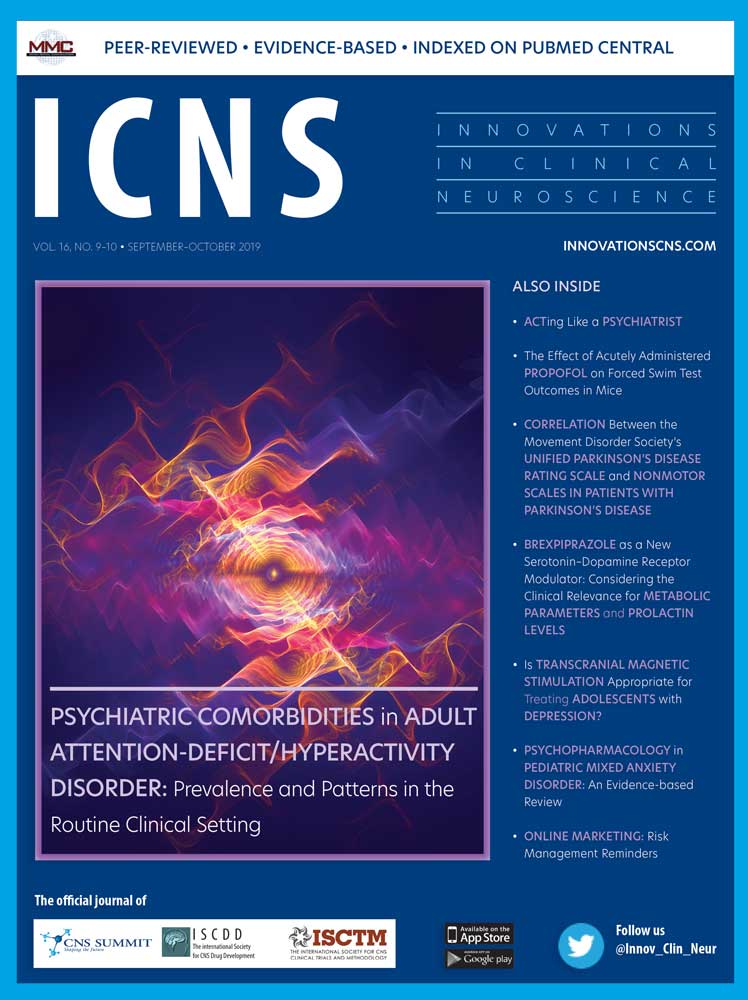
Dear Colleagues:
Welcome to the September–October 2019 edition of Innovations in Clinical Neuroscience (ICNS). We start this issue with a study titled, “Psychiatric Comorbidities in Adult Attention-deficit/Hyperactivity Disorder: Prevalence and Patterns in the Routine Clinical Setting.” In this surveillance study, Ohnishi et al assessed the prevalence of comorbid psychiatric disorders, evaluated relationships between comorbid psychiatric disorders and demographic characteristics, and explored the patterns of these comorbid disorders and their relationships with ADHD subtypes in 575 adult patients with ADHD. The data (e.g., age, sex, age at diagnosis, number of comorbidities, and severity of ADHD symptoms) were collected from postmarketing surveillance of methylphenidate extended-release tablets in adult ADHD and analyzed. Results showed that 301 (52.35%) of the adult patients with ADHD had at least one concurrent psychiatric disorder, leading the authors to their conclusion that there is a high prevalence of psychiatric comorbidities in adult patients with ADHD. The authors suggest that better understanding of the patterns of comorbid psychiatric diagnoses in relation to subtypes of ADHD could be useful in ADHD diagnosis in adults.
Next, in this month’s “Psychotherapy Rounds” department, Carlile et al describe acceptance and commitment therapy (ACT) in their article “ACTing Like a Psychiatrist.” ACT is a form of cognitive behavioral therapy that predominately focuses on addressing a patient’s relationship with certain negative thoughts and emotions rather than attempting to alter them. The authors focus on the six core processes of ACT therapy, reviewing application techniques in clinical practice.
This article is followed by a study titled, “The Effect of Acutely Administered Propofol on Forced Swim Test Outcomes in Mice,” by Daniel et al. Here, the investigators evaluated the impact that acute propofol treatment alone or in combination with subchronic fluoxetine had on mice during a forced swim test (FST) performance. There have been anecdotal reports of improved mood in humans following propofol-induced anesthesia, which motivated the authors to conduct this study. According to these preclinical results, 50mg/kg of propofol reduced immobility time during the FST, compared to the control group, which suggests greater resilience to stress. Their results are consistent with a small open-label study of propofol used in treatment-resistant depression, which, according to the authors warrants additional research into the potential antidepressant effects of propofol.
Next, investigators assessed whether responses on the Movement Disorder Society’s Unified Parkinson’s Disease Rating Scale (MDS-UPDRS) correlates with responses to other scales used in patients with PD. In their article, “Correlation Between the Movement Disorder Society’s Unified Parkinson’s Disease Rating Scale and Nonmotor Scales in Patients with Parkinson’s Disease,” Driver-Dunckley et al evaluated assessment scale results from study subjects who were enrolled in the Arizona Study of Aging and Neurodegenerative Disorders (AZSAND)and had completed all of the PD assessment scales included in this study within a one-month period (N=96). The authors reported a high correlation between the Scales for Outcomes in Parkinson’s Disease–Autonomic (SCOPA-AUT) and the MDS-UPDRS questions on excessive saliva, constipation, and swallowing, as well as strong correlations between the Neuropsychiatric Inventory Questionnaire (NPI-Q) and MDS-UPDRS questions on the depression and anxiety. Poor correlations were found between MDS-UPDRS and other questions from SCOPA-AUT and NPI-Q scales, and poor correlations were found between MDS-UPDRS and the Mayo Sleep Questionnaire and Epworth Sleepiness Scale in general. The authors conclude that employing multiple methods for assessing nonmotor symptoms in patients with PD is important.
After this, Nakamura and Nagamine share the results of their study in which patients who were either introduced to brexpiprazole because of nonadherence to traditional medications or were switched from apripiprazole, olanzapine, or paliperidone were assessed to measure the impact that brexpiprazole has on various parameters. In their article titled “Brexpiprazole as a New Serotonin–Dopamine Receptor Modulator: Considering the Clinical Relevance for Metabolic Parameters and Prolactin Levels,” the authors report that brexpiprazol treatment displayed a low propensity to influence metabolic parameters (lipids and glucose) and had minimal impact on prolactin levels, but recognize that additional prospective studies with longer follow-up and larger groups of patients are required to support their findings.
Following this, in their mini-review article titled, “Is Transcranial Magnetic Stimulation (TMS) Appropriate For Treating Adolescents with Depression?” Narang et al briefly review currently available treatments for children and adolescents with depression, describe the negative, potentially long-long effects of untreated or undertreated depression in these patients, and explore the potential usefulness of TMS as a therapeutic option for this patient population. The authors conclude that TMS appears to be a safe, effective therapeutic intervention for children and adolescents with depression. They acknowledge that randomized, controlled trials with more patients and longer follow-up are needed before firm conclusions can be drawn.
After that, Naveed et al present the results of their literature review in the article titled, “Psychopharmacology in Pediatric Mixed Anxiety Disorder: An Evidence-based Review” The authors summarize evidence from case reports, case series, open-label trials, and randomized, controlled trials. on pharmacologic treatments for mixed anxiety disorders in children and adolescents. They focused their research on generalized anxiety disorder, social anxiety disorder, and separation anxiety disorder in this patient population.
And finally, we wrap up the issue with our “Risk Management” column. This month, in the article “Online Marketing: Risk Management Reminders,” Vanderpool reviews potential risks that online marketing can present for physicians. The author also provides suggestions on how to manage these risks.
Sincerely
Amir Kalali, MD
Editor, Innovations in Clinical Neuroscience





